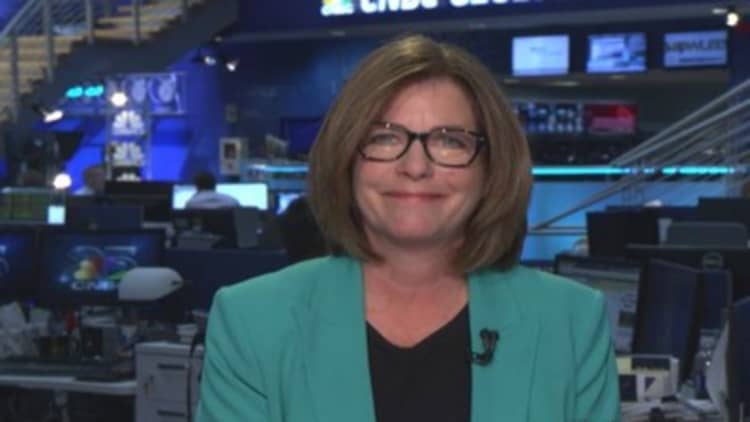The Fed delivered a mixed message Wednesday, and the markets may increasingly start to ignore its dovish tones if the economy continues to improve, analysts say.
In its statement, the central bank acknowledged the chances that inflation will stay below its 2 percent target, read as a hawkish sign by traders. But while pointing to improvements in the labor market and a lower unemployment rate, the Fed also noted that there remains a "significant under-utilization of labor resources," a dovish signal.
Stocks recovered some losses after the statement, but in the Treasury market, rates held near levels reached earlier in the session. Rates rose earlier in the day after a surprisingly strong report showed second-quarter GDP growth of 4 percent. Yields at the shorter end of the curve held multiyear highs. The two-year and three-year durations are where traders place bets on Fed rate moves.
"The data is coming in very convincing now. They (the Fed) were a little bit slow to take action. Inflation has normalized and they did acknowledge that in the statement," said Nomura's Jens Nordvig, global head of G-10 currency strategy. "As time passes, and very importantly as we get some hints that Q3 is also strong, they will have to adjust."
For that reason, markets will remain hyperfocused on data, particularly employment-related data like Friday's July jobs report. But Nordvig said the employment cost index, due Thursday, will be extremely important as the Fed closely monitors it.
There are also weekly unemployment claims Thursday at 8:30 a.m. ET and Chicago PMI at 9:45 a.m.
Read More

"Wages are actually crucial. I think if there is any movement in wages, all bets are off," said Nordvig. He said the second-quarter employment cost report is expected to be up 0.5 for the period. "If there's an upside surprise, it will move the markets," he said.
The market has been debating whether the Fed will move ahead of when most economists expect—mid-2015 or the third quarter. There is a view that the data will force the central bank to move sooner, and some economists believe the Fed will not hike rates earlier, but it could have to hike more aggressively once it begins to raise rates.
"We still think the Fed is going to be moving and the data will support it moving early in '15," said Rick Rieder, co-head of Americas fixed income at BlackRock, on "Closing Bell." He said some in the markets viewed the Fed's message Wednesday as hawkish but he took it as more dovish.
Strategists said the fact that Philadelphia Fed President Charles Plosser dissented over his objection to the Fed saying it would hold rates low for a "considerable" period also perplexed the market though it was not surprising. Mark Luschini, chief investment strategist at Janney Montgomery, said that type of dissent could increase over the next couple of months.
"This is going to be problematic for the market. At some point, if the economic data continues to show the kind of activity we've been seeing in the last two to four weeks, both in the labor market and PMIs, and to still have the Fed talking about keeping rates so low—they're setting up the market for an opportunity to be confused, and that could be a problem," said Luschini.
Read MoreIt does not feel like a 4% economy: Aetna CEO
Nordvig said he would use the dip in the dollar after the Fed's statement to add to positons, and that he expects the dollar's recent gains to accelerate. The August through October period should be crucial because it is likely during that time that there will be a shift in Fed communications, he noted.
He said his call was not based on the Fed statement but the fact that the central bank is getting closer to its targets and that will be the message from more Fed members.
"Bonds are still getting hammered. What we saw in the bond market for the better part of the day did make sense," said Luschini.
He said if employment continues to make gains at the 200,000-a-month pace and unemployment continues to fall, "that could put pressure on the Fed narrative."
Milton Ezrati, market strategist and economist at Lord Abbett, said the Fed did as expected. "They continue to taper. They say the economy has recovered. They are a little more definite," he said.
Ezrati said there was nothing that should make the market think the Fed is going to change its time frame, and the bond market is pricing in rate hikes for next year.
"One way it creates confusion is that the Fed's not talking with a unified voice. I think (former Fed Chairman Ben) Bernanke and (Fed Chair Janet) Yellen encourage people to dissent on the hawkish side," Ezrati said. "They want to let the long-term thinkers, the worry warts of the street ... to have a voice in the process. Right now, it's Mr. Plosser. Plosser is taking the lead here. I think he's serving Yellen's purpose, and I think he knows it too."
—By CNBC's Patti Domm


